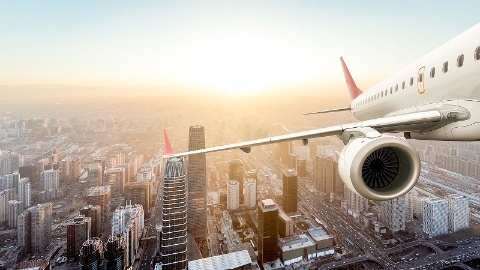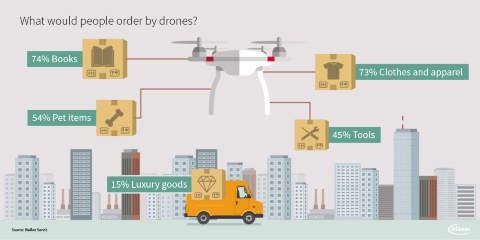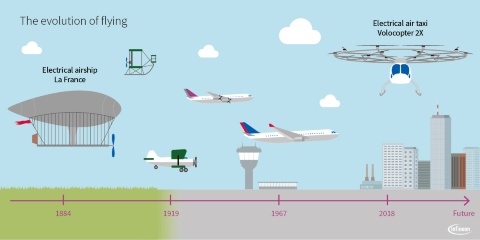
The flight to Delhi leaves at 11:50. It takes 15 minutes to get to the airport. But today not by subway or automobile: the air taxi stops outside your apartment. The doors close silently, the aircraft rises into the air with a humming sound. Below: Traffic congestion. The electric motor transports the flying taxi through the air – quietly and with no emissions. A brief stop at the terminal, transfer to the hybrid aircraft, which takes off on time and flies to India with significantly reduced emissions.
Although this sounds like a vision in the distant future, it could become reality in just a few years. Mobility in the air will also be electric according to strategy consulting firm Roland Berger: “The question is not if, but when electric aircraft will be common.” Dozens of aircraft projects are ready for takeoff in Europe and in the rest of the world. Roland Berger investigated 70 different models, all of which are due to be airborne by 2030 at the latest.
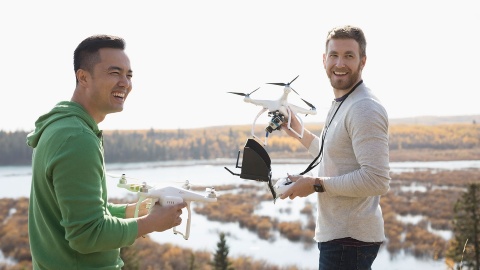
E-planes and Drones lift off
Electric cars and commercial vehicles are already on our roads. In the future, e-aircraft, such as multicopters – drones with several rotors – may become a common sight. Electric aircraft get their drive energy from an on-board battery that is charged with electricity. Smaller models, such as drones, fly completely with electricity, larger aircraft for more than 15 people still rely on a second energy source.
What are the benefits of electric flying?
Electrically driven aircraft are especially beneficial for the environment. According to the German Federal Environment Agency, conventional airplanes emit about 214 grams of greenhouse gases per passenger kilometer. An automobile (!) with an internal combustion engine emits just 140 grams. Admittedly, emissions from individual aircraft have been reduced thanks to improvements, but the total number of air miles has risen considerably. In the future, an increasing number of passengers will travel by air: According to the statistics portal Statista, the number reached four billion for the first time in 2017. Due to the corona crisis this figure dropped to just over 1.7 billion people in 2020. However, for 2021 the forecast assumes a noticeable recovery of 35 percent to 2.4 billion.
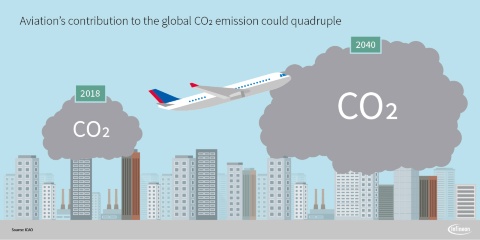
Until now, aviation has been responsible for about 2.4 percent of all CO2 emissions worldwide. The International Civil Aviation Organization (ICAO) has calculated that by 2040 this share could rise by a factor of four due to the increased number of flights. However, CO2 is not the only substance that aircraft emit. They also produce nitric oxide, water vapor, and fine particulates. The emissions not only have an impact on the environment, they also have an adverse effect on our health.
But the aviation industry has set itself ambitious targets: by 2050, CO2 emissions should be reduced by approximately 75 percent. In the near future, emissions will also become expensive for airlines: the members of the IACO have agreed to compensate for their CO2 emissions and buy emission units. In other words: an airline that emits less than it is permitted to can sell the right to produce more emissions to another airline. By 2050, the noise emitted from airplanes is also due to fall by 60 percent. At present, takeoff and landing are particularly responsible for enormous noise pollution.

How can these targets be met? Electrically operated aircraft are one possibility. They are much quieter since, on takeoff, propulsion is not delivered by loud jet engines but by low-noise electric motors. Bans on nighttime flying would then no longer be necessary. In addition, as opposed to conventional airplanes, e-aircraft produce no emissions. If the electricity comes from renewable sources, they are completely CO2-neutral. A further advantage: Electric motors are less prone to breakdowns. They consist of much fewer components and do not need oil, cooling water, an exhaust system, or gears. Consequently, they require less maintenance. Electric drive systems also provide the required torque at any air density, temperature and speed which enables safer flights.
Hence, electric aircraft offer numerous benefits. Fuel prices and regulations encourage the electrification of aircraft. By 2035, more than 45 percent of all aircraft drive systems could be at least partially electric.
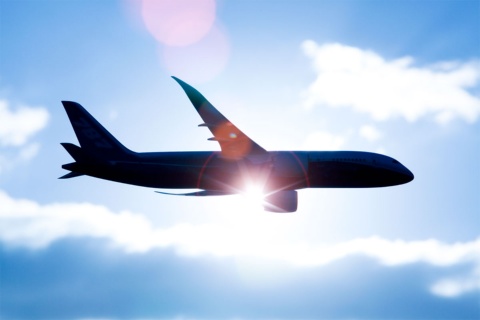
Challenges for electric air traffic
However, from a technical aspect, the evolution in aviation is not easy to implement. Airbus CEO Tom Enders described electric flight as one of the “greatest industrial challenges of our time”. Many decades will pass before all flights are powered by electricity. Initially, electric drives will be used for multicopters that transport goods or passengers in cities. By 2025, they could take off from small landing sites, as they rise into the air vertically. This could be followed by regional flights of up to 1,200 kilometers. It will take longer before we see long-haul electric planes.
It is not only the technology that is a challenge, the flying objects themselves are an issue: large-scale individual air traffic will be possible only with electric drones and air taxis. But if there were too many drones in cities, we would need additional regulations to guarantee safety – such as on traffic routes and landing sites. Another issue is that many electric air taxis will fly autonomously. The authorities will then have to impose regulations about minimum distances to prevent collisions.
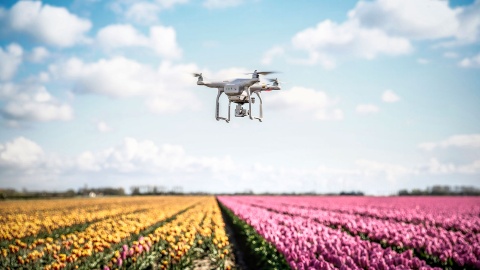
Transport drones and e-taxis ready for liftoff
At present, the drones we see in the air are mainly unmanned – as toys or to carry cameras. They already have an electric drive, in other words, they do not have to become electric. In the not too distant future, we can expect to see an increasing number of multicopters and VTOL aircraft. VTOL stands for vertical take-off and landing. There are several scenarios where VTOL aircraft could be used: small versions could transport goods, while larger ones may transport ourselves in the future.
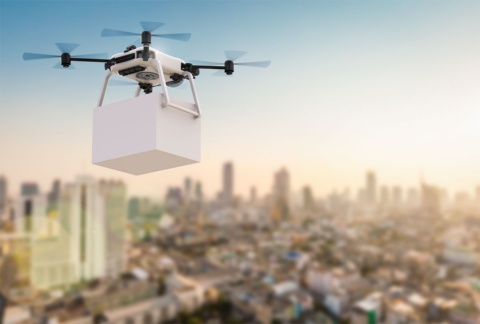
Electric aviation begins with delivery drones
US e-tailer Amazon announced the first delivery drones in 2013 by the name of “Prime Air”. They can transport packages weighing up to 2.5 kilograms over distances up to 16 km. Google, DHL, UPS, DPD, Boeing and the Chinese company JD.com are also working on concepts for e-drones to be used for parcel services. Initial tests have been carried out in Japan, Dubai, Singapore, Switzerland, and other countries. In the US, the Federal Aviation Administration (FAA) has allowed the use of delivery drones under strict conditions. But the drones are not allowed in densely populated areas – which makes home parcel delivery impossible. In Germany, at present, no approvals have yet been given for deliveries by air.
Step two: electric air taxis
Later, electric multicopters will not only transport goods, but also passengers. Porsche Consulting believes that we could see the first commercial air taxis in 2025. Ten years after that there will be 23,000 of them, earning $32 billion from transporting passengers. According to the study, a ten-minute flight from Munich Airport to the city center could cost about €100. Several companies are currently developing concepts for air taxis. Some of them are more like helicopters while others resemble small airplanes. Operation of the aircraft will be simple with one or two joysticks.
Dubai plans to use passenger drones as taxis in the near future – and to do this the authorities are working together with the German startup Volocopter. The electric air taxi “Volocopter 2X” carried out an unmanned test flight in 2017, flying over the emirate at a height of 60 meters. Other companies are also building air taxis: CityAirbus is working on an air taxi for four passengers and Uber plans to launch its air taxi service “Uber Air” in US cities and operate the corresponding landing areas by 2023. “Jet” from the startup Lilium Aviation based near Munich, Germany, is also intended as an air taxi. There is room for two passengers in the carbon capsule. China is already electrifying large numbers of automobiles – so it is not really surprising that the country is also producing an electric air taxi: the four by four meter “Ehang 184” has room for one passenger. UK car maker Rolls-Royce is developing a hybrid electric drone: a gas turbine will generate the electricity. The five-seater could be ready for serial production as early as 2025.
There are enormous differences with regard to the distances that the planned electric air taxis can fly: they are able to fly between 16 and 300 kilometers – which should be enough for city traffic. The models reach speeds between 130 and 320 km/h. Only the hybrid aircraft from Rolls Royce is faster and flies further: the as yet unnamed VTOL machine flies at speeds of about 400 km/h and can cover an amazing 800 kilometers.
Autonomous flight – even before autonomous driving?
Many of the air taxis will fly completely autonomously or will at least offer that possibility. For example, the Volocopter can be operated by a pilot or can also fly autonomously. Other models like the Chinese “Ehang 184” fly fully autonomously.
E-aircraft were already around in the 19th century
Electrically driven aircraft are not just a 21st century idea: French inventor Arthur Constantin Krebs flew his electric airship La France in 1878 together with Charles Renard and Adrien Duté-Poitevin. It was equipped with a 6.25 kW electric motor. Six years later, La France flew for 23 minutes and reached a speed of 19.8 km/h. Around the same time, brothers Albert and Gaston Tissandier also built an electrically driven airship.
The first manned electric aircraft took off in Austria in 1973. The Militky MB-E1 flew with a 15 kW motor for between 9 and 14 minutes. In the 20th century, several developers worked on electric aircraft and helicopters – in most cases they were unsuccessful due to the lack of battery capacity.

Electric and hybrid aircraft
Companies and startups are not only working on small air taxis but also on electric aircraft that could transport several passengers. They are to be used in regional traffic in just a few years. However, we are unlikely to see long-haul flights with electric planes for many years to come.
Electric aircraft
Easyjet has specific plans for electric airplanes: in collaboration with US startup Wright Electric, the company wants to build electric airplanes for up to 150 passengers. The plan is to fly them by 2027. “Alice” from Israeli startup Eviation is also in the planning stage. It has room for nine passengers. On board is a 900 kWH lithium ion battery. On the other hand, the two-seater electric airplane from Slovenian company Pipistrel is ready for serial production. Equipped with a 50 kW electric motor and a 21 kWh battery pack, it can fly for about an hour.
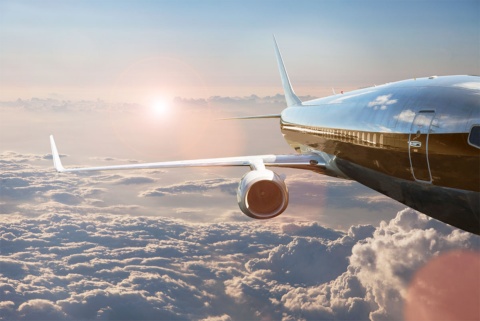
Hybrid aircraft
Because of the limited battery capacity at present, some companies are working on hybrid drive systems. For example, Airbus, which is building a medium-haul aircraft for 100 passengers in collaboration with Rolls Royce and Siemens: The “e-Fan X” will operate with three gas turbines and an electric motor. Siemens is developing the 2 mW motor, while Rolls-Royce will deliver the gas turbine. This will generate the electricity that is then stored in a battery. The jet could be available commercially between 2025 and 2030.
British startup Starling presented a hybrid jet which takes off and lands vertically like the Volocopter. Consequently, it could be used as a flying bus in cities. The electric propellers are in the fuselage. In the air, the engines turn vertically upward, while a diesel engine helps with acceleration.
Range of electric and hybrid aircraft
Currently, electric and hybrid aircraft could easily manage flights within Europe or the US. According to the plans, they will be able to fly distances of 540 to 1,200 kilometers.
Norway's vision of electric flight
Norway is already a pioneer with regard to electric mobility – on the road and in the air. Thanks to enormous funding, for the first time more cars with hybrid and electric drive systems than internal combustion engines were registered in the Scandinavian country in 2017. From 2025, only zero-emission cars are to be sold in Norway. But there is more: from 2040, all short haul flights in the country are supposed to be electric. The government has assigned the public corporation Avinor to develop the corresponding plans. As a result of this, the first commercial route with an electric airplane could be flown as early as 2025. The government also has an incentive program to encourage companies to invest more in developing electric aircraft.
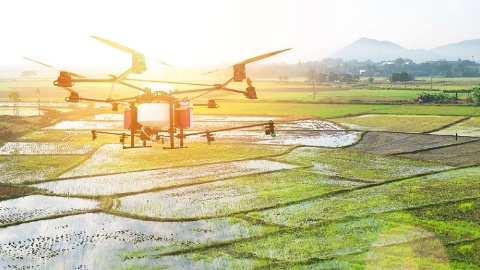
The technology in drones and electric aircraft
In aircraft powered by jet fuel, the high power of the jet engines is needed on takeoff – at high altitudes a lot less power is required. As opposed to this, electric aircraft need absolutely no internal combustion engine or jet propulsion. Instead, they get their energy from electricity stored in batteries on board which is then provided to the motor and rotors. With hybrid aircraft, batteries provide support with additional energy.
Technical challenges for electric aircraft
A purely electric airplane gets its electricity from batteries. In the plane from Israeli company Eviation, these are aluminum-air batteries that are mounted on the tail and wingtips. However, they weigh 2,700 kilograms; the complete plane weighs 5,400 kilograms. The fact that the batteries are often still too heavy is an important criterion for aircraft manufacturers: every kilogram less means more fuel efficiency. Another challenge for electric aircraft is the low power density of the batteries: they can store only three percent of the energy that is in one kilogram of jet fuel.
How are electric aircraft charged?
This is also tricky: electric aircraft cannot charge their batteries as easily as an electric car. Cars simply go to a charging station and, depending on the model, remain there for at least an hour. However, with airplanes downtime is unprofitable. The two-seater from Pipistrel demonstrates how this can work with small aircraft: the batteries can be replaced in a few minutes or charged in just one hour.
How energy is created during the flight
But there is another way: in many cases, at least some of the energy can be recovered during the flight. Different technologies for this are being tested: Pipistrel aircraft recuperate almost 13 percent of the consumed energy when approaching for landing in idle mode. With the help of the DC-AC converter they recover energy like a coasting electric car and return this to the battery. The “Electric Sun Flyer 2” two-seater from Bye Aerospace can generate electricity when gliding: the on-rushing air causes the propellers to rotate. In other words, the motor works like a generator that produces electricity and stores it in the battery.
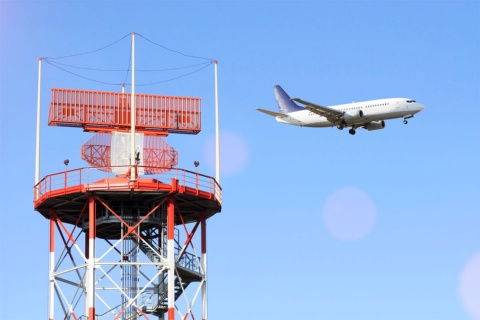
Other developers are researching aircraft that obtain their energy from solar cells on the wings. This is then stored in batteries. In 2015, Swiss pilots Bertrand Piccard and André Borschberg completed the first round-the-world solar-powered flight. The wings of “Solar Impulse 2” were equipped with 17,000 solar cells.
However, at present many aircraft manufacturers are working on hybrid models. They generate electricity during the flight, such as through jet fuel in gas turbines. The electricity is then stored in on-board batteries. A generator feeds the electric motors which then drive turbines or ducted fans. These hybrid models could reduce fuel consumption by about a quarter. In the future, fuel cells could replace jet fuels as a provider of electricity in the air.

How is Infineon involved in electric aircraft?
One of the major challenges for developers of electric aircraft is the construction of more efficient and lighter batteries. Since the start of the 1990s, the energy density of batteries and the efficiency of electric motors have more than doubled. But that is not enough, for example, to power long-haul aircraft. In other words, for electric airplanes to have serious commercial possibilities, battery capacity must increase considerably. This would allow longer distances to be flown. Therefore, the battery units must not only become smaller, they must also have a higher power density. Infineon helps to face this challenge – for instance with active “battery balancing”, which increases the capacity and life of batteries by more than ten percent: a smart battery management system continuously controls the functions and charge of all battery cells and improves their utilization. This prevents a situation where individual cells store less and less energy due to aging.
The weight of the airplane is also a major issue for aircraft manufacturers. This is where semiconductors based on silicon carbide (SiC) play a role: the new components from Infineon help reduce the weight of electric components – such as the inverter and motors for the drive. This allows drive units to be built that are light, compact, and highly efficient. These are exactly the properties that are needed for electric aircraft to lift off.

Outlook
Mobility will become electric – gradually also in the air. We can also expect to see the first electric air taxis within the next ten years. Cities such as Dubai have already planned for their use. Mail order companies also want to use drones to deliver packages to customers. This will make the cities of the future cleaner: no CO2 or other emissions are generated during transportation. A further advantage: electric aircraft are quiet. However, it is not yet clear how aviation will be regulated if large numbers of individual, transport, and taxi drones are in the air.
From around 2025, we could also expect to see electric and hybrid aircraft in the air. But it will still be some time until these are widespread: on average, airplanes are used for 30 years and airlines will only replace their fleets gradually. Electric airplanes will not fly long-haul routes in the foreseeable future. For this to happen, batteries have to be lighter and more powerful.
But a lot will happen in this area in the coming years: new technologies make batteries more efficient and smaller. From 2025, they may also be suitable for larger aircraft, assumes strategy consulting firm Roland Berger. And then, around the middle of the century, it may be natural for us to board an electric airplane and fly to the other side of the world. With no emissions or noise.
Last update: July 2021
